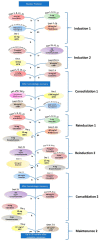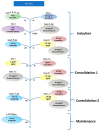Approach to the Adult Acute Lymphoblastic Leukemia Patient
- PMID: 31390838
- PMCID: PMC6722778
- DOI: 10.3390/jcm8081175
Approach to the Adult Acute Lymphoblastic Leukemia Patient
Abstract
During recent decades, understanding of the molecular mechanisms of acute lymphoblastic leukemia (ALL) has improved considerably, resulting in better risk stratification of patients and increased survival rates. Age, white blood cell count (WBC), and specific genetic abnormalities are the most important factors that define risk groups for ALL. State-of-the-art diagnosis of ALL requires cytological and cytogenetical analyses, as well as flow cytometry and high-throughput sequencing assays. An important aspect in the diagnostic characterization of patients with ALL is the identification of the Philadelphia (Ph) chromosome, which warrants the addition of tyrosine kinase inhibitors (TKI) to the chemotherapy backbone. Data that support the benefit of hematopoietic stem cell transplantation (HSCT) in high risk patient subsets or in late relapse patients are still questioned and have yet to be determined conclusive. This article presents the newly published data in ALL workup and treatment, putting it into perspective for the attending physician in hematology and oncology.
Keywords: acute lymphoblastic leukemia; clinical management; follow-up.
Conflict of interest statement
The authors declare no conflict of interest. The funders had no role in the design of the study; in the collection, analyses, or interpretation of data; in the writing of the manuscript, or in the decision to publish the results
Figures





References
LinkOut - more resources
Full Text Sources

